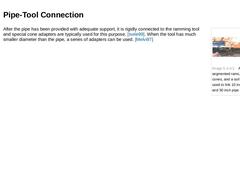
|
(Image: A combination of segmented rams, tapered ram cones, and a soil removal adapter used to link 10 inch ramming tool and 30 inch pipe [Melvi97]) After the pipe has been provided with adequate support, it is rigidly connected to the ramming tool and special cone adapters are typically used for this purpose. [Isele99]. When the tool has much smaller diameter than the pipe, a series of adapters can be used. [Melvi97] |
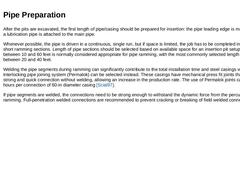
|
After the pits are excavated, the first length of pipe/casing should be prepared for insertion: the pipe leading edge is made ready and a lubrication pipe is attached to the main pipe. Whenever possible, the pipe is driven in a continuous, single run, but if space is limited, the job has to be completed in a series of short ramming sections. Length of pipe sections should be selected based on available space for an insertion pit setup. A length between … |
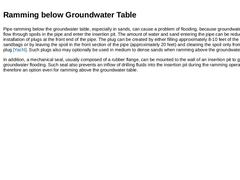
|
Pipe ramming below the groundwater table, especially in sands, can cause a problem of flooding, because groundwater can easily flow through spoils in the pipe and enter the insertion pit. The amount of water and sand entering the pipe can be reduced with the installation of plugs at the front end of the pipe. The plug can be created by either filling approximately 8-10 feet of the pipe with sandbags or by leaving the spoil in the front section of … |
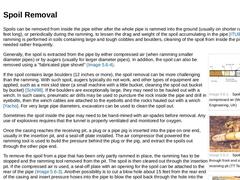
|
Spoils can be removed from inside the pipe either after the whole pipe is rammed into the ground (usually on shorter rams, up to 80 feet long), or periodically during the ramming, to lessen the drag and weight of the spoil accumulating in the pipe [ITU99]. When pipe ramming is performed in soils containing large and tough cobbles and boulders, cleaning of the spoil from inside the pipe may be needed rather frequently. |
(Image: Spoil removal with compressed … |
|
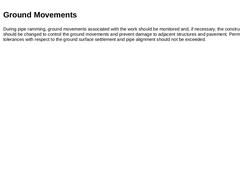
|
During pipe ramming, ground movements associated with the work should be monitored and, if necessary, the construction method should be changed to control the ground movements and prevent damage to adjacent structures and pavement. Permissible tolerances with respect to the ground surface settlement and pipe alignment should not be exceeded. |
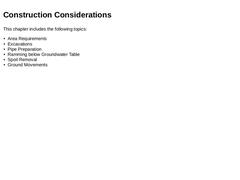
|
|
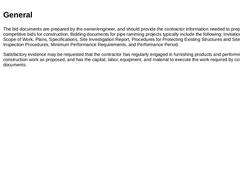
|
The bid documents are prepared by the owner/engineer, and should provide the contractor information needed to prepare competitive bids for construction. Bidding documents for pipe ramming projects typically include the following: Invitation for Bids, Scope of Work, Plans, Specifications, Site Investigation Report, Procedures for Protecting Existing Structures and Site Features, Inspection Procedures, Minimum Performance Requirements, and Performance … |
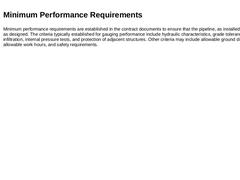
|
Minimum performance requirements are established in the contract documents to ensure that the pipeline, as installed, will perform as designed. The criteria typically established for gauging performance include hydraulic characteristics, grade tolerances, water infiltration, internal pressure tests, and protection of adjacent structures. Other criteria may include allowable ground displacement, allowable work hours, and safety requirements. |

|
A list of references and standards for equipment, materials, safety, etc. should be provided to the contractor for use in planning and bid presentation. |
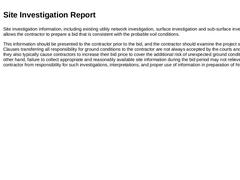
|
Site investigation information, including existing utility network investigation, surface investigation and sub-surface investigation, allows the contractor to prepare a bid that is consistent with the probable soil conditions. This information should be presented to the contractor prior to the bid, and the contractor should examine the project site on his own. Clauses transferring all responsibility for ground conditions to the contractor are not … |
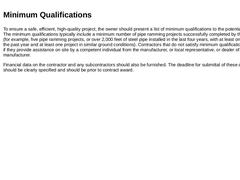
|
To ensure a safe, efficient, high-quality project, the owner should present a list of minimum qualifications to the potential contractors. The minimum qualifications typically include a minimum number of pipe ramming projects successfully completed by the contractor (for example, five pipe ramming projects, or over 2,000 feet of steel pipe installed in the last four years, with at least one project in the past year and at least one project in similar … |
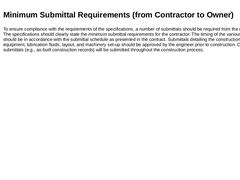
|
To ensure compliance with the requirements of the specifications, a number of submittals should be required from the contractor. The specifications should clearly state the minimum submittal requirements for the contractor. The timing of the various submittals should be in accordance with the submittal schedule as presented in the contract. Submittals detailing the construction process, equipment, lubrication fluids, layout, and machinery set-up … |
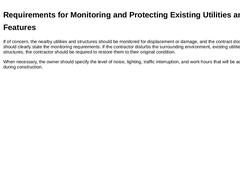
|
If of concern, the nearby utilities and structures should be monitored for displacement or damage, and the contract documents should clearly state the monitoring requirements. If the contractor disturbs the surrounding environment, existing utilities, or structures, the contractor should be required to restore them to their original condition. When necessary, the owner should specify the level of noise, lighting, traffic interruption, and work hours … |
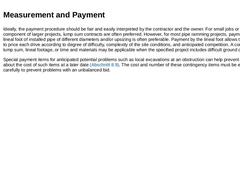
|
Ideally, the payment procedure should be fair and easily interpreted by the contractor and the owner. For small jobs or for a small component of larger projects, lump sum contracts are often preferred. However, for most pipe ramming projects, payment by the lineal foot of installed pipe of different diameters and/or upsizing is often preferable. Payment by the lineal foot allows the contractor to price each drive according to degree of difficulty, … |

|
During the ramming operation, if an obstruction is encountered such that the pipe gets stuck, an excavation may need to be made at the location of the obstruction to allow the installation to continue. In such cases, the contractor should inform the owner or the engineer and ask for direction. The bid documents should address such circumstances so that the contractor is aware, prior to bid, how these problems will be handled, including information … |
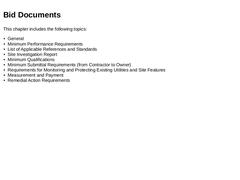
|
|
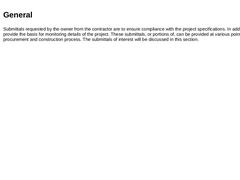
|
Submittals requested by the owner from the contractor are to ensure compliance with the project specifications. In addition, they provide the basis for monitoring details of the project. These submittals, or portions of, can be provided at various points during the procurement and construction process. The submittals of interest will be discussed in this section. |
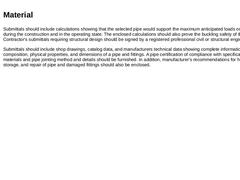
|
Submittals should include calculations showing that the selected pipe would support the maximum anticipated loads on the pipe during the construction and in the operating state. The enclosed calculations should also prove the buckling safety of the pipe. All Contractor's submittals requiring structural design should be signed by a registered professional civil or structural engineer. Submittals should include shop drawings, catalog data, and manufacturers … |
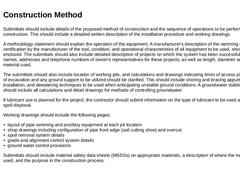
|
Submittals should include details of the proposed method of construction and the sequence of operations to be performed during the construction. This should include a detailed written description of the installation procedure and working drawings. A methodology statement should explain the operation of the equipment. A manufacturer's description of the ramming system, and a certification by the manufacturer of the tool, condition, and operational … |
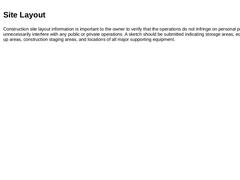
|
Construction site layout information is important to the owner to verify that the operations do not infringe on personal property or unnecessarily interfere with any public or private operations. A sketch should be submitted indicating storage areas, equipment set-up areas, construction staging areas, and locations of all major supporting equipment. |
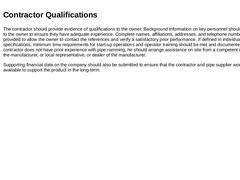
|
The contractor should provide evidence of qualifications to the owner. Background information on key personnel should be furnished to the owner to ensure they have adequate experience. Complete names, affiliations, addresses, and telephone numbers should be provided to allow the owner to contact the references and verify a satisfactory prior performance. If defined in individual specifications, minimum time requirements for start-up operations and … |
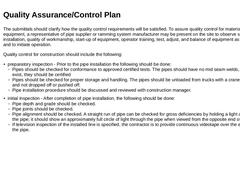
|
The submittals should clarify how the quality control requirements will be satisfied. To assure quality control for materials and equipment, a representative of pipe supplier or ramming system manufacturer may be present on the site to observe site conditions, installation, quality of workmanship, start-up of equipment, operator training, test, adjust, and balance of equipment as applicable, and to initiate operation. Quality control for construction … |
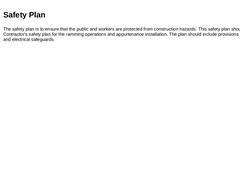
|
The safety plan is to ensure that the public and workers are protected from construction hazards. This safety plan should include a Contractor's safety plan for the ramming operations and appurtenance installation. The plan should include provisions for lightning and electrical safeguards. |
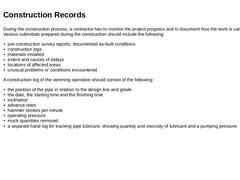
|
During the construction process, a contractor has to monitor the project progress and to document how the work is carried out. Various submittals prepared during the construction should include the following: - pre-construction survey reports, documented as-built conditions
- construction logs
- materials installed
- extent and causes of delays
- locations of affected areas
- unusual problems or conditions encountered
A construction log of the ramming operation … |
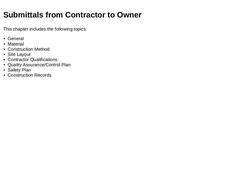
|
|